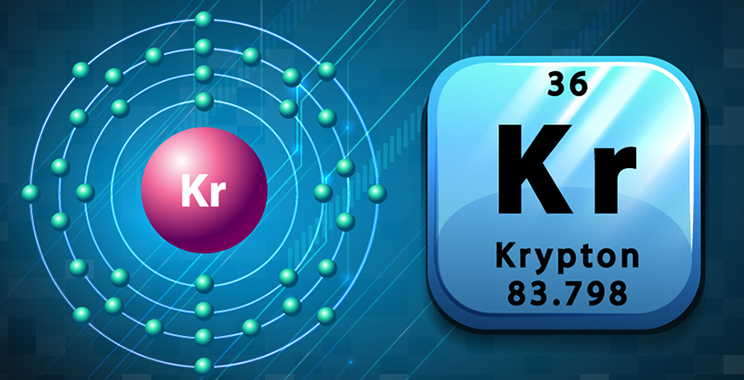Math Is Fun Forum
You are not logged in.
- Topics: Active | Unanswered
- Index
- » Science HQ
- » Krypton
Pages: 1
#1 2025-06-12 17:40:16
- Jai Ganesh
- Administrator

- Registered: 2005-06-28
- Posts: 52,723
Krypton
Krypton
Gist
Krypton (Kr) is a colorless, odorless, noble gas with atomic number 36. It's a trace element in the atmosphere and is known for its inertness and various applications, including lighting, photography, and lasers.
It does not react with anything except fluorine gas. Krypton is used commercially as a filling gas for energy-saving fluorescent lights. It is also used in some flash lamps used for high-speed photography. Unlike the lighter gases in its group, it is reactive enough to form some chemical compounds.
Summary
Krypton is a chemical element; it has symbol Kr and atomic number 36. It is a colorless, odorless noble gas that occurs in trace amounts in the atmosphere and is often used with other rare gases in fluorescent lamps. Krypton is chemically inert.
Krypton, like the other noble gases, is used in lighting and photography. Krypton light has many spectral lines, and krypton plasma is useful in bright, high-powered gas lasers (krypton ion and excimer lasers), each of which resonates and amplifies a single spectral line. Krypton fluoride also makes a useful laser medium. From 1960 to 1983, the official definition of the metre was based on the wavelength of one spectral line of krypton-86, because of the high power and relative ease of operation of krypton discharge tubes.
Details
Krypton (Kr), chemical element, a rare gas of Group 18 (noble gases) of the periodic table, which forms relatively few chemical compounds. About three times heavier than air, krypton is colorless, odorless, tasteless, and monatomic. Although traces are present in meteorites and minerals, krypton is more plentiful in Earth’s atmosphere, which contains 1.14 parts per million by volume of krypton. The element was discovered in 1898 by the British chemists Sir William Ramsay and Morris W. Travers in the residue left after a sample of liquid air had boiled almost entirely away.
Element Properties
atomic number : 36
atomic weight : 83.798
melting point : −157.4 °C (−251.3 °F)
boiling point : −153.4 °C (−244.1 °F)
density (1 atm, 0 °C [32 °F]) : 3.733 g/litre (0.049 ounce/gallon)
oxidation numbers : 0, 2
Properties of the element
Because its boiling point (−153.4 °C, or −244.1 °F) is about 30–40 °C (50–70 °F) higher than those of the major constituents of air, krypton is readily separated from liquid air by fractional distillation; it accumulates along with xenon in the least volatile portion. These two gases are further purified by adsorption onto silica gel, redistillation, and passage over hot titanium metal, which removes all impurities except other noble gases.
Krypton is used in certain electric and fluorescent lamps and in a flashlamp employed in high-speed photography. Radioactive krypton-85 is useful for detecting leaks in sealed containers, with the escaping atoms detected by means of their radiation. Krypton is named from the Greek word kryptos, “hidden.”
When a current of electricity is passed through a glass tube containing krypton at low pressure, a bluish white light is emitted. The wavelength of an orange-red component of light emitted by stable krypton-86, because of its extreme sharpness, served from 1960 to 1983 as the international standard for the meter. (One meter equaled 1,650,763.73 times the wavelength of this line.)
Natural krypton is a mixture of six stable isotopes: krypton-84 (56.99 percent), krypton-86 (17.28 percent), krypton-82 (11.59 percent), krypton-83 (11.5 percent), krypton-80 (2.29 percent), and krypton-78 (0.36 percent). Krypton has isotopes of every mass number from 69 through 101; of these isotopes,25 are radioactive and are produced by fission of uranium and by other nuclear reactions. The longest-lived of these, krypton-81, has a half-life of 229,000 years. After it has been stored a few days, krypton obtained by nuclear fission contains only one radioactive isotope, krypton-85, which has a half-life of 10.7 years, because all the other radioactive isotopes have half-lives of 3 hours or less.
Additional Information
Krypton is an inert (or “noble”) gas and, as such, is not bound up in molecules but exists as single atoms.1 It is the fourth atom in group 18 of the periodic table of elements, after helium, neon, and argon. Its concentration in Earth’s atmosphere is ≈1 ppm by volume.
In 1898, British chemists William Ramsay and Morris Travers discovered krypton as the residue of evaporating almost all of the other components of liquid air. For his work in the discovery of several inert gases, Ramsay was awarded the Nobel Prize in Chemistry in 1904.
Like all inert gases, the boiling and melting points of krypton are only a few degrees apart (see “fast facts”). Krypton has few practical applications, mostly in bright white light bulbs used in photography and in devices used in physical and chemical research. At one time, the wavelength of light emitted by the 86Kr isotope was used to define the meter, but in 1983, the meter’s definition was changed to a function of the speed of light.
In comic books dating back to 1949, “Krypton” was the planet where Superman was born; and “kryptonite” was the only substance that the superhero was vulnerable to. Over the years, the mythological kryptonite was endowed with much more extensive chemistry than real krypton gas.

It appears to me that if one wants to make progress in mathematics, one should study the masters and not the pupils. - Niels Henrik Abel.
Nothing is better than reading and gaining more and more knowledge - Stephen William Hawking.
Offline
Pages: 1
- Index
- » Science HQ
- » Krypton